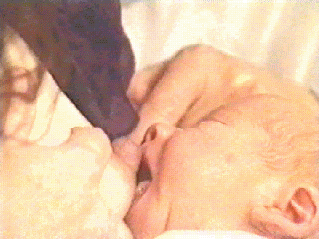Breastfeeding is a normal physiological process for babies. They possess all the neurobehavioural and psychomotor reflexes to do so by themselves. It is a learned art which develops and matures as they imprint their memory. The mother provides her body and her breasts supply the milk to nurture her baby. Hence the baby and mother are dependent on each other for the success of breastfeeding.
Righard (1998) found in their study that 94% of the mothers experiencing breastfeeding problems had incorrect positioning and latch-on.
There is a lot of emphasis on correct latch; however, achieving a good latch is absolutely dependent on baby being positioned well (in the first few months of life). In the huge majority of cases a well-latched baby and understanding the baby's "feed me" cues are all the mother has to know to breastfeed successfully.
Righard (1998) found in their study that 94% of the mothers experiencing breastfeeding problems had incorrect positioning and latch-on.
There is a lot of emphasis on correct latch; however, achieving a good latch is absolutely dependent on baby being positioned well (in the first few months of life). In the huge majority of cases a well-latched baby and understanding the baby's "feed me" cues are all the mother has to know to breastfeed successfully.
Stimulate the baby by rubbing mother's nipples near baby's lips until baby's mouth is wide open. Then ensure than a big portion of the areola gets into the baby's mouth.
Mother & baby has to be calm during moments of attempting latch on to ease success.A new mother might need adequate support and be patient enough to get hold of the proper latching methods.
However, once both mother & baby are comfortable nursing, it gets easier day by day.
Why is it important to establish a proper latching method?
1. To efficiently deliver milk to baby.
2. To prevent cracked nipples or other form of related injury.
3. To prevent inefficient delivery of milk to baby, which results in unsatisfied baby --> baby clinging to breasts --> sore/ cracked nipples --> mother stressed due to clingy baby, painful nipples, & engorged breasts (due to unefficient breast emptrying) --> less milk production (due to increase inhibitory factors & stress).
Signs of Proper Latching:
1. Baby's Mouth Wide Open
2. Baby's Lower Lip Drawn Outward
3. Baby's Chin in contact with Mother's Breast
4. A large portion of mother's areola is in baby's mouth.
5. More of mother's upper areola is visible.
Signs of Baby Efficiently Receiving Milk:
1. Baby suckling in slow and deep rhythm.
2. Audible swallowing sounds.
3. Baby's cheeks are full and round and not drawn/sunken in during feeding.
4. Baby will let go naturally when satisfied.
Can you spot the which is the proper latching method in the illustration below?
Can you spot the which is the proper latching method in the illustration below?
Some mothers need to, or prefer to, shape the breast slightly (eg. very large breasts, flattish nipples, very full breasts).
If this is needed, the mother's technique may involve:
- putting some pressure near to the base of the nipple, at the point where the nose is pointing, causes the nipple to tilt towards the nose. As the bottom lip is firmly planted at about the edge of the areola the finger (or thumb) that is causing the tilting can then roll the nipple so it just brushes under, or folds under baby's top lip, OR
- one finger can be placed on either side of the areola to "sandwich" the breast and tilt the nipple to touch the top lip and offer the underside of the areola onto the baby's bottom lip.




No comments:
Post a Comment